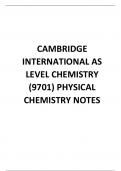College aantekeningen
CAMBRIDGE INTERNATIONAL AS LEVEL CHEMISTRY (9701) PHYSICAL CHEMISTRY NOTES
- Vak
- Instelling
Excel in your AS-level Physical Chemistry studies with our specialized and concise notes! Tailored for AS-level students, these notes delve into the core principles of Physical Chemistry, providing a clear and focused understanding of essential topics. Designed with exam success in mind, our notes ...
[Meer zien]



